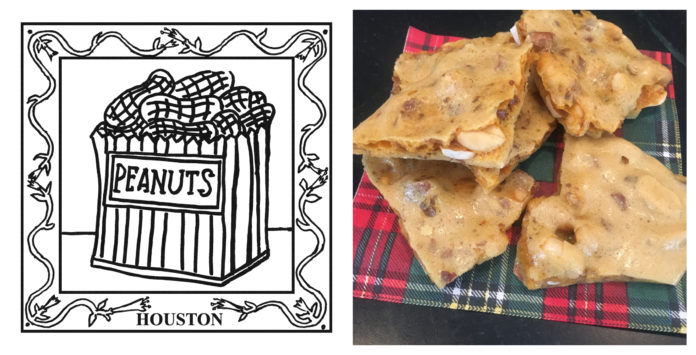
The Cullman Tribune celebrated the Alabama Bicentennial (1819-2019) with statewide field reporting by Alabama Master Gardener/Botanical Artist Ben Johnson South. This year-long feature, “The 67-County Alabama Garden Party,” spotlighted different counties each week. Each county got its own “quilt block,” along with a historical profile, and we shared a recipe specific to the area. Houston County is the last county in the series. Next, all 67 counties will be put in a book to commemorate the Bicentennial.
Houston County
Alabama has had many kinds of heroes and heroines across our 200-year history, but it truly takes a heroic amount of courage and super-human willpower to stop after eating just one Houston County peanut.
Dothan, Houston County’s largest metro area, is the destination for the National Peanut Festival and this part of the state is recognized as “The Peanut Capital of North America.” I know this could sound nutty, but peanuts aren’t really nuts. Like beans and peas, peanuts are members of the legume family.
Our state’s plant-centric foodways have benefited from the embrace of a variety of cultures. Planting okra and watermelons came from African agriculture, Scandinavian settlers created the enormously successful peach industry in central Alabama and peanut plants (Arachis hypogaea) originated on the South American continent in Paraguay.
South Americans have cultivated peanuts for 3,500 years. The country of Brazil, alone, has 63 species of peanuts.
Two of the objectives I’ve had in writing this series, The 67-County Alabama Garden Party, which is the first time any state in the U.S. has taken a comprehensive, county-by-county perspective of all the positive and pleasurable places, PLANTS + PEOPLE intersect, are: 1) To plant ideas for celebrating plants across the state, and 2) To encourage botanically-oriented business development. Our look at Houston County allows both of those goals to be explored.
Houston County is the last of this Bicentennial celebration of Alabama plants because I approached the study from the state’s oldest established county, Washington, to the newest. This southeast corner of the map, approved by the Legislature in February 1903, is the only county in Alabama to be established after the 19th century.
Often it is the newest settlements that bring the freshest viewpoints and innovation. Houston County recognized the rich soil which had supported cotton production in the 1800s was diminished and new crop diversification was needed to support future farming in Alabama. Peanuts are solar-powered plants that naturally enhance the soil with nitrogen. Additionally, livestock love to eat the peanut plant tops. Or, after the nuts are harvested, the remaining part of the plant can be used for mulch.
To learn more about crop rotation and understand the historical importance of agri-business in Alabama, I encourage you to visit the state’s impressive Agricultural Museum, here in Dothan’s Landmark Park, and the adjoining 1890s living history farm. (see details below)
GOOD NEWS: “INFANT-SAFE” PEANUT INTRODUCTION- After years of public alarm about “peanut allergies,” the American Academy of Pediatrics in 2015 approved early introduction of peanuts to the diets of children at 6 months of age. Peanuts and peanut butter are high in protein and fiber, a great source of Vitamin E and the good kind of fat that actually reduces cholesterol levels instead of raising them.
Peanuts on a menu can go from soup to nuts, appetizer to dessert. (At the end of this story, see the 1957 award-winning recipe for Houston County peanut brittle which launched a successful business.)
Alabamians have valued growing peanuts even before statehood (1819), but the popularity for this plant was greatly accelerated during the American Civil War. Peanut oil was substituted for northern-traded whale oil and four factories were built in Southern states to supply the need of this vegetable oil in lubricating factories and even powering locomotives. Ground peanuts took the place of ground coffee when Union ships were unwelcome.
Alabama is one of the top peanut-producing states in the nation and the industry generates millions of dollars in our state annually. Today, more than 85% of Alabama home pantries have peanut butter as a staple. Nearly half of the U.S. peanut crop gets whipped into peanut butter.
Peanuts can thrive in any of Alabama’s 67 counties. The caveat here is to select the type of peanut one grows for the specific geography. For instance, wild strains of “Arachis hirsute,” (aka “hairy peanuts”) have been found growing in the Andes Mountains at the frigid altitude of 8,000 feet. Hilly Appalachian counties in Alabama like DeKalb and Cleburne could become “The Hairy Peanut Capital of The World.” Some enterprising graphic designer should go forward and create a logo for that in 2020s. We will all get the T-shirt.
Peanuts have four major types, all of which can be successfully grown in Alabama:
*RUNNERS- The peanut butter makers. These are tough, vigorous plants and are the peanuts most-commonly grown in southernmost Alabama along the Florida line. Disease-resistant, “Southern Runner” is a prime choice, producing medium-sized kernels.
*VIRGINIA- The “bigguns” prized for cocktail snacks. These tasty beauties are used in the famed “nut dish” of Ritz-Carlton Hotel bars. These peanuts are grown primarily in Virginia and North Carolina but could thrive in parts of Alabama where there are 130-150 days of warm weather. These big, high-energy nuts are great for hikers on Alabama’s many nature trails.
*VALENCIAS- Are my favorite peanut for eating raw and are the most popular for growing in home gardens. “Tennessee Reds” would be ideal for some areas of Alabama, and “Georgia Reds” for other parts of the state. Could we develop a superior-to-all-states “Alabama Red” peanut? Let’s take a tip from Houston County farmers and innovate.
*SPANISH- Has a fine flavor and produces small, rounded nuts ideal for candies. These peanuts are drought-tolerant, which is increasingly important in this period of global warming.
A good source for purchasing a variety of peanut seeds to try your skill at “goober gardening” is Southern Exposure Seed Exchange. www.southernexposure.com
Here are other positive and pleasurable ways PLANTS + PEOPLE come together in Houston County:
*ASHFORD FARMERS’ MARKET- 312 Midland Street, Ashford, AL 36312; Saturdays 7 a.m.-noon, June 1-Aug. 2
*POPLAR HEAD FARMERS’ MARKET- Dothan Civic Center parking lot, 126 North St. Andrews St., Dothan, AL 36301; Saturdays 8 a.m.-noon, June 2-July 27
*TAYLOR FARMERS’ MARKET- 1469 State Highway 605, Taylor, AL 36301; Fridays 4-8 p.m., June 7-July 26
*WIREGRASS FARMERS’ MARKET- 1699 Ross Clark Circle, Dothan, AL 36302; Tuesdays, Fridays and Saturdays 7 a.m.-noon, June 5-Aug. 5
*HOUSTON COUNTY FARMSTANDS- Aplin Farms (Dothan), Billy Owens (Cottonwood), David Bell (Dothan), Gulledge Produce (Dothan), Jerry Shiver (Gordon), Lamond Wells (Gordon), Linda Willingham (Dothan)
*HOUSTON COUNTY U-PICK FARMS- Anderson Farms (Pansey), Bell Farms (Dothan), Estress Farms (Cottonwood), Maria’s Vineyard (Dothan)
*ALABAMA STATE AGRICULTURAL MUSEUM- 430 Landmark Dr., Dothan, AL 36303; includes a 135-acre living history farmstead, one-room schoolhouse, general store, 1900s church, elevated boardwalks, nature trails, a barnyard playground, planetarium and picnic areas
*NATIONAL PEANUT FESTIVAL- Honors local farmers and celebrates the harvest season; Nov. 6-15, 2020
*DOTHAN AREA BOTANICAL GARDENS- 5130 Headland Ave., Dothan, AL 36303, 334-793-3224; 50 acres of cultivated gardens, nature trails and wooded landscape highlighting native plants of the Wiregrass region
*HOUSTON COUNTY PLANTS ADVICE/EDUCATION- Alabama Cooperative Extension System local office at 1699 Ross Clark Circle, Suite 4, Dothan, AL 36301, 334-794-4108
*PLANTING AN IDEA- Most peanuts grown in the United States are planted within a 100-mile radius of Houston County. As a long-established authority on growing peanuts, this area could suggest peanut varieties which can thrive in each of Alabama’s 67 counties. Additionally, there are possible branding opportunities for Houston County peanut plants and seeds.
Y’ALL COME to Houston County on your 67-County, Alabama Garden Party tour! You’d be nuts, or maybe that’s legumes, not to.
Many thanks to Laurie Johnson, my sister-in-law and friend, who created the great majority of recipes included in this Bicentennial series, The 67-County, Alabama Garden Party. For this article, Laurie connected with their son’s delightful mother-in-law, Marilyn Adams, who hails from Columbia, Alabama in Houston County and has for many years lived in Webb, another Houston County community. Marilyn helped us track down Kathleen Oakley’s (also from Columbia) prize-winning peanut brittle recipe from the 1957 National Peanut Festival cooking contest.
Houston County – Kathleen Oakley’s Prize Winning Peanut Brittle
Houston County’s largest city, Dothan, is host to the annual National Peanut Festival which includes a peanut recipe contest. In 1957, the contest was won by Kathleen Oakley of Columbia, for her (soon-to-become-famous) peanut brittle. Her first-prize gift was a gas stove – this is a serious contest!
For several years afterward, Kathleen and her whole family made, packaged and sold her peanut delicacy from their home. Her story and recipe are re-counted here as supplied by, and with the permission of, her oldest daughter, Ann Ewing, of Birmingham. Sixteen years old when her mother won, Ann, her younger brothers and sisters and their father, George, all helped in Kathleen’s business. They cooked the brittle in iron skillets, poured the hot candy onto buttered marble slabs where they pulled it thin as it cooled. They couldn’t keep up with demand as the reputation of the delicious, prize-winning peanut treat spread. Many thanks to Ann for sharing their family story and her mother’s famous recipe!
Ingredients:
- 1 1/2 cups sugar
- 1/2 cup light Karo syrup
- 1/2 cup boiling water
- 2 cups raw, shelled peanuts
- Piece of butter or margarine the size of an egg, plus more for buttering the cooling surface
- 1 tsp. baking soda
Instructions:
- Put sugar, syrup and hot water into an iron skillet. (If you measure the hot water after the syrup, it helps get the last syrup out of the cup.) Bring to a boil while stirring with a metal spoon until mixture spins a thread when dripped from the spoon.
- Add peanuts and cook 5-10 minutes, stirring constantly, until peanuts change color as they must “roast” during the cooking process. The time depends on the size of the peanuts.
- Remove from heat. Add butter or margarine and soda, stirring well. Mixture will foam up and darken.
- Pour out onto a buttered, heat-proof surface (like a marble slab or large platter). Spread out with the back of the spoon, and then pull as thin as you can using the spoon or forks (or your hands, once cool enough to touch). When candy is cool and brittle, break into pieces and store in airtight containers.
Also, check out Alabama Bicentennial: 200 ways to save Alabama for the next 200 years.
Copyright 2020 Humble Roots, LLC. All Rights Reserved.



























